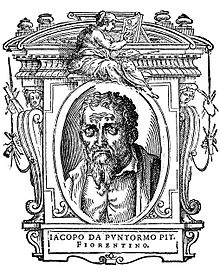https://en.wikipedia.org/wiki/Pontormo
Pontormo | |
|---|---|
 Illustration from Lives of the Most Excellent Painters, Sculptors, and Architects by Giorgio Vasari, 1568 edition | |
| Born | Jacopo Carucci May 24, 1494 Pontorme near Empoli, Italy |
| Died | January 2, 1557 (aged 62) Florence, Italy |
| Nationality | Italian |
| Known for | Painting |
Notable work | The Deposition from the Cross |
| Movement | Mannerism |
Jacopo Carucci (May 24, 1494 – January 2, 1557), usually known as Jacopo da Pontormo, Jacopo Pontormo or simply Pontormo, was an Italian Mannerist painter and portraitist from the Florentine School. His work represents a profound stylistic shift from the calm perspectival regularity that characterized the art of the Florentine Renaissance.[1] He is famous for his use of twining poses, coupled with ambiguous perspective; his figures often seem to float in an uncertain environment, unhampered by the forces of gravity.
RENAISSANCE ART AND ARCHITECTURE




Everyday Art
1月2日下午8:34 ·
Happy death day Jacopo Carucci better known as Pontormo (1494 - 1557)
An Italian Mannerist from Tuscany, he did love his elongated figures (Mannerism emphasises & exaggerates proportion, balance, & ideal beauty, all in twisty turny contorted poses - ok that’s not the dictionary definition but it’s what it is!)
But his best thing? Twinning!! Using figures in opposing poses to create a really lyrical floating atmosphere & provide a wonderfully satisfying symmetry. So if one figure faces forward, another faces back, if one leans to the right, another will incline to the left - all in the name of balance & harmony - And oh the colours!!
However I can never see a Pontormo without coming away asking “ Why the long face....”
THE DEPOSITION FROM THE CROSS - 1525–1528 oil on canvas
PORTRAIT OF A HALBERDIER - 1528 - 30 oil & tempera on panel transferred to canvas
VISITATION OF CARMIGNANO - c.1528 oil on panel
Pregnant Mary meets meets pregnant St Elizabeth and here they really do look pregnant, which makes a change in art...
ST MATTHEW THE EVANGELIST - c.1525 oil on panel
The stuff of nightmares if you ask me, all limbs & curves like maggots in a tin - extraordinary
***
Richard Wagner's opera The Flying Dutchman (1843) is adapted from an episode in Heinrich Heine's satirical novel The Memoirs of Mister von Schnabelewopski (Aus den Memoiren des Herrn von Schnabelewopski) (1833), in which a character attends a theatrical performance of The Flying Dutchman in Amsterdam. Heine had first briefly used the legend in his Reisebilder: Die Nordsee (Pictures of Travel: the North Sea) (1826), which simply repeats from Blackwood's Magazine the features of the vessel being seen in a storm and sending letters addressed to persons long since dead. In his 1833 elaboration, it was once thought that it may have been based on Fitzball's play, which was playing at the Adelphi Theatre in London, but the run had ended on 7 April 1827 and Heine did not arrive in London until the 14th.[nb 5] Heine was the first author to introduce the chance of salvation through a woman's devotion and the opportunity to set foot on land every seven years to seek a faithful wife. This imaginary play, unlike Fitzball's play, which has the Cape of Good Hope location, in Heine's account is transferred to the North Sea off Scotland. Wagner's opera was similarly planned to take place off the coast of Scotland, although during the final rehearsals he transferred the action to another part of the North Sea, off Norway.



沒有留言:
張貼留言